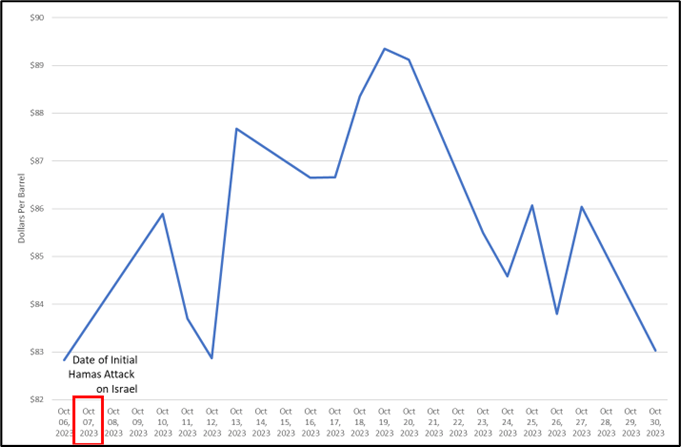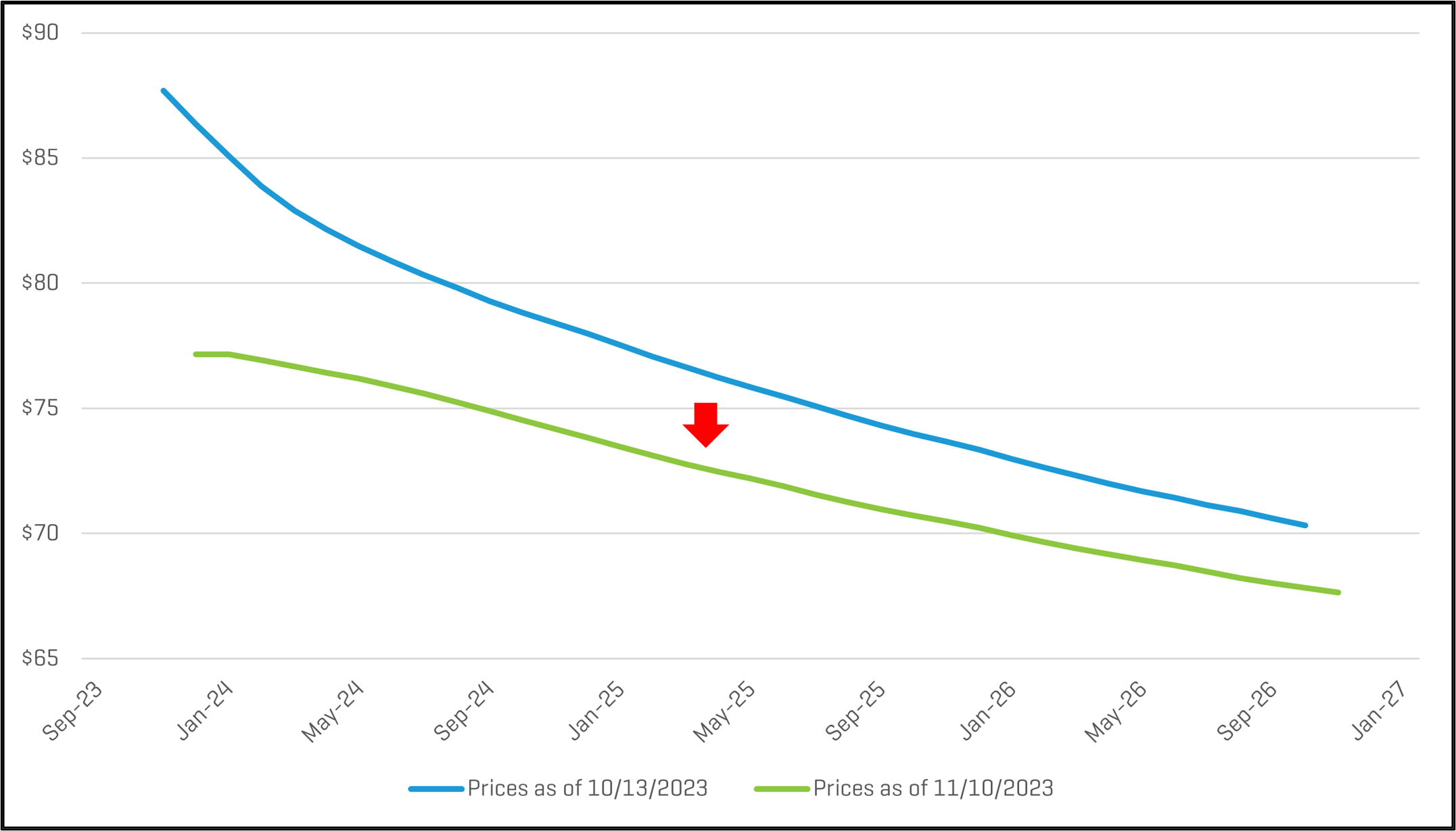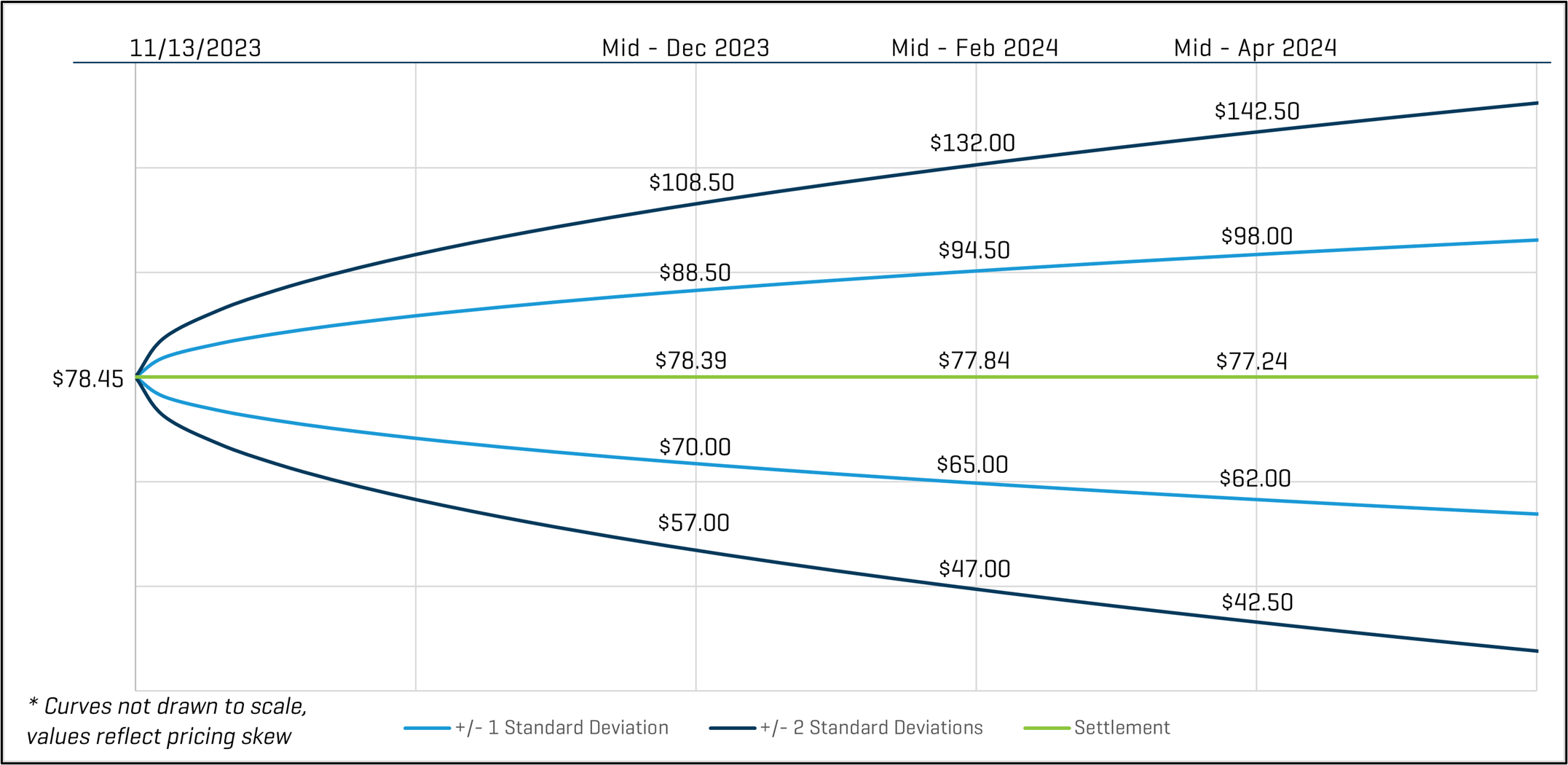Israel-Hamas War and the Potential Impact on Oil Prices
Israel-Hamas War and the Potential Impact on Oil Prices
On October 7, 2023, Hamas invaded Israel. Following this attack, Israeli Prime Minister Benjamin Netanyahu declared a state of war.
According to ABC News, “A month after Hamas terrorists rained thousands of rockets down on Israel and infiltrated the country by air, sea and land in an unprecedented surprise attack on Oct. 7, the region stands on the brink of war — with fears of a wider conflict and thousands dead on both sides of the Israel-Gaza border.”1
Not surprisingly, spot oil prices initially increased in reaction to the potential disruption in supply from Mideast producers. Oil prices increased by $3.00 per barrel on the first trading day after the attack.
WTI Oil Spot Prices Since October 7 Hamas Attack on Israel

Prices continued to increase as fighting increased, up to almost $90 per barrel, before turning downward. Interestingly, at the time of this blog post, oil prices subsequently have reversed from that high to approximately the same level as before the war started.
The Case for Higher Oil Prices
Looking ahead, some experts expect oil prices to increase significantly if the conflict escalates, drawing in Iran and other Middle East producing countries. As an example, the accounting firm EY’s chief economist, Greg Daco, predicted that “oil prices could surge well into to the triple-digits and market volatility could skyrocket in the most severe scenario of an uncontained Israel-Hamas war.”2
The war thus far has sparked fears of a wider regional conflict, but markets so far have been relatively muted in their response. The most severe outcome of the war is what Daco referred to as an “uncontained scenario,” in which the war escalates and could ultimately see the involvement of the U.S. or Iran, or both.
In that situation, oil prices could immediately spike by $50 a barrel, notching $150 a barrel in late 2023. Global inflation could also rise, climbing 1.5 percentage points above EY’s baseline 2024 forecast due to higher energy prices.
“This scenario would create a true headache for central bankers faced with an inflationary shock at a time when inflation remains well above official targets,” Daco said.3
The Case for Lower Oil Prices
Concurrent with the start of the Israel-Hamas war, however, U.S. crude oil production managed to hit a monthly record-high in August 2023, boosted by productivity gains and more efficient operations. U.S. exploration and production companies are drilling longer laterals and deploying rigs to the most promising areas to get more bang for their buck.4
In Texas, the top oil-producing state, the article above goes on to note that crude oil production reached a record high of 5.7 million barrels per day (bpd) in August, per the most recent monthly energy economic analysis by Texas Oil & Gas Association (TXOGA) Chief Economist Dean Foreman.
“Texas’ production of oil and natural gas has achieved records despite relatively modest drilling activity. Productivity gains and leveraging wells that have been drilled but not yet completed have provided a tailwind,” Foreman wrote at the end of September.
Producers in the Permian in Texas and New Mexico and the other shale plays have boosted production of crude oil despite a loss of 117 rigs so far this year, per Baker Hughes data as of October 27. But the main driver of production gains has been higher efficiency in drilling and other operations.5
According to Reuters, supply concerns caused oil prices to fall more than 4% on Tuesday, November 7, 2023, to their lowest since late July, as mixed Chinese economic data and rising OPEC exports eased fears about tight markets and as the dollar strengthened. U.S. West Texas Intermediate crude futures settled at $77.37 a barrel, down $3.45, or 4.3%.
“OPEC crude exports are up by about 1 million barrels per day (bpd) since their August low, as a result of seasonally lower domestic demand in the Middle East. It seems it is too much supply to be absorbed by oil consuming nations,” Staunovo said.6
On the demand side, China’s crude oil imports in October showed robust growth but its total exports of goods and services contracted at a quicker pace than expected.
“The data signals the continued decline in the Chinese economic outlook driven by deteriorating demand in the country’s largest export destination: the West,” City Index analyst Fiona Cincotta said.7
Other Factors Impacting Oil Prices
- Besides the outbreak of war in Gaza, Russia’s war with Ukraine continues to impact Russia’s oil and gas production. Additionally, U.S. funding for Israel is being met with headwinds given our current involvement in Ukraine.
- The U.S.’ Strategic Petroleum Reserve serves as a tool for the U.S. government to stabilize oil markets in times of significant supply disruptions. The U.S. has used the reserve in the past to mitigate the impact of Middle Eastern conflicts on domestic oil prices. The Strategic Petroleum Reserve is currently at a historic low level following the decision to draw down supplies in an attempt to lower oil prices for U.S. citizens.
Long-Term Impacts on Oil Prices?
The Israel-Hamas war’s long-term impact on oil prices will ultimately depend on the duration of the conflict and the extent of the damage to oil infrastructure in the region. A prolonged war could lead to sustained higher oil prices, while a quick resolution might result in a temporary spike in prices followed by a return to pre-conflict levels.
WTI Strip Prices Decrease Despite War
Spot prices and futures prices for the West Texas Intermediate (WTI) contract decreased by approximately $9.00 per barrel in the near term and decreased approximately $2.50 over the longer term.
WTI Strip Prices - One Month Change

As shown, the oil price curve remains in a state of “backwardation,” reflecting the market’s expectation of lower future spot prices.
Oil Price Outlook
The price distribution below shows the crude oil spot price on November 13, 2023, as well as the predicted crude oil prices based on options and futures markets. Light blue lines are within one standard deviation (σ) of the mean, and dark blue lines are within two standard deviations.
WTI Crude Oil $/BBL

Based on these current prices, the markets indicate there is a 68% chance oil prices will range from $65.00 and $94.50 per barrel in mid-February 2024. Likewise, there is roughly a 95% chance that prices will be between $47.00 and $132.00. By mid-April 2024, the one-standard deviation (1σ) price range is $62.00 to $98.00 per barrel, and the two-standard deviation (2σ) range is $42.50 to $142.50 per barrel.
Key Takeaways
Remember that option prices and models reflect expected probabilities, not certain outcomes, but that does not make them any less useful. Throughout most of 2023, crude oil spot prices fluctuated within the range of $70 to $80 per barrel.
Over the previous few months, we have observed spot prices primarily above that range, with a year-to-date high around $95.00 per barrel. During that time, we observed an increase in futures price volatilities. As spot prices have trended towards the $70 to $80 per barrel range, futures price volatilities have begun to decrease, as evidenced by the futures price ranges observed.
Comparing the four-months futures price ranges (April 2024 prices of this report vs. March 2024 prices of last month’s report), the spread for the 1σ range decreased $7.00 per barrel and the spread for the 2σ range decreased $1.50 per barrel. For mid-March 2024 pricing as of November 13, 2023, the 1σ range had a spread of $36.00 per barrel, and the 2σ range has a spread of $100.00 per barrel. For comparison, in 2022 we observed 1σ and 2σ price ranges in excess of $65.00 and $150.00, respectively.
- “Israel-Hamas War: Timeline and key developments in month of war,” Bill Hutchinson, ABC News, November 9, 2023.
- “Oil prices would soar to $150 and market volatility would skyrocket in the most severe scenario for the Israel-Hamas war, EY chief economist says,” Jennifer Sor, Markets Insider, October 23, 2023.
- Ibid.
- “How the U.S. is pumping more oil with fewer rigs,” Tsvetana Paraskova, Oil & Gas 360, November 6, 2023.
- Ibid.
- “Oil dives 4% to lowest since July on demand worry, strong dollar,” Shariq Khan, Reuters, November 7, 2023.
- Ibid.






